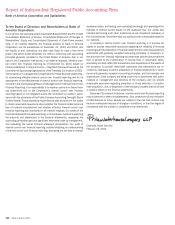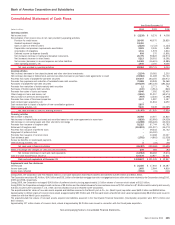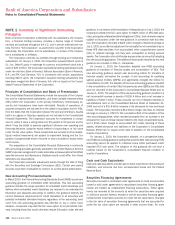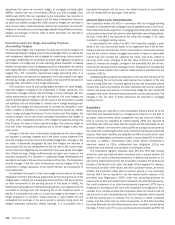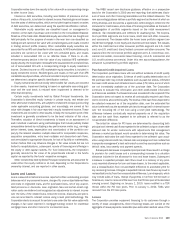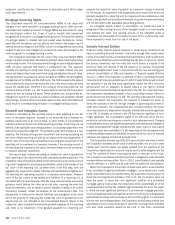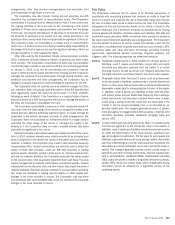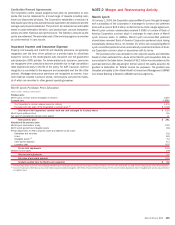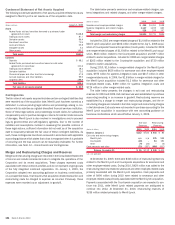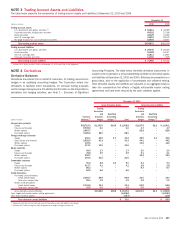Bank of America 2010 Annual Report Download - page 152
Download and view the complete annual report
Please find page 152 of the 2010 Bank of America annual report below. You can navigate through the pages in the report by either clicking on the pages listed below, or by using the keyword search tool below to find specific information within the annual report.leased property less unearned income. Leveraged leases, which are a form of
financing leases, are carried net of nonrecourse debt. Unearned income on
leveraged and direct financing leases is accreted to interest income over the
lease terms using methods that approximate the interest method.
Allowance for Credit Losses
The allowance for credit losses, which includes the allowance for loan and
lease losses and the reserve for unfunded lending commitments, represents
management’s estimate of probable losses inherent in the Corporation’s
lending activities. The allowance for loan and lease losses and the reserve for
unfunded lending commitments exclude amounts for loans and unfunded
lending commitments accounted for under the fair value option as the fair
values of these instruments reflect a credit component. The allowance for
loan and lease losses does not include amounts related to accrued interest
receivable other than billed interest and fees on credit card receivables as
accrued interest receivable is reversed when a loan is placed on nonaccrual
status. The allowance for loan and lease losses represents the estimated
probable credit losses in funded consumer and commercial loans and leases
while the reserve for unfunded lending commitments, including standby
letters of credit (SBLCs) and binding unfunded loan commitments, represents
estimated probable credit losses on these unfunded credit instruments
based on utilization assumptions. Credit exposures deemed to be uncollect-
ible, excluding derivative assets, trading account assets and loans carried at
fair value, are charged against these accounts. Cash recovered on previously
charged off amounts is recorded as a recovery to these accounts. Manage-
ment evaluates the adequacy of the allowance for loan and lease losses
based on the combined total of these two components.
The Corporation performs periodic and systematic detailed reviews of its
lending portfolios to identify credit risks and to assess the overall collectability
of those portfolios. The allowance on certain homogeneous consumer loan
portfolios, which generally consist of consumer real estate within the home
loans portfolio segment and credit card loans within the credit card and other
consumer portfolio segment, is based on aggregated portfolio segment
evaluations generally by product type. Loss forecast models are utilized for
these portfolios which consider a variety of factors including, but not limited
to, historical loss experience, estimated defaults or foreclosures based on
portfolio trends, delinquencies, bankruptcies, economic conditions and credit
scores.
The Corporation’s home loans portfolio segment is comprised primarily of
large groups of homogeneous consumer loans secured by residential real
estate. The amount of losses incurred in the homogeneous loan pools is
estimated based upon how many of the loans will default and the loss in the
event of default. Using statistically valid modeling methodologies, the Corpo-
ration estimates how many of the homogeneous loans will default based on
the individual loans’ attributes aggregated into pools of homogeneous loans
with similar attributes. The attributes that are most significant to the prob-
ability of default and are used to estimate default include refreshed LTV or in
the case of a subordinated lien, refreshed combined loan-to-value (CLTV),
borrower credit score, months since origination (i.e., vintage) and geography,
all of which are further broken down by present collection status (whether the
loan is current, delinquent, in default or in bankruptcy). This estimate is based
on the Corporation’s historical experience with the loan portfolio. The esti-
mate is adjusted to reflect an assessment of environmental factors not yet
reflected in the historical data underlying the loss estimates, such as changes
in real estate values, local and national economies, underwriting standards
and the regulatory environment. The probability of default of a loan is based on
an analysis of the movement of loans with the measured attributes from either
current or each of the delinquency categories to default over a twelve-month
period. Loans 90 or more days past due or those expected to migrate to 90 or
more days past due within the twelve-month period are assigned a rate of
default that measures the percentage of such loans that will default over their
lives given the assumption that the condition causing the ultimate default
presently exists as of the measurement date. On home equity loans where the
Corporation holds only a second-lien position and foreclosure is not the best
alternative, the loss severity is estimated at 100 percent.
The allowance on certain commercial loans (except business card and
certain small business loans) is calculated using loss rates delineated by risk
rating and product type. Factors considered when assessing loss rates
include: the value of the underlying collateral, if applicable, the industry of
the obligor, and the obligor’s liquidity and other financial indicators along with
certain qualitative factors. These statistical models are updated regularly for
changes in economic and business conditions. Included in the analysis of
consumer and commercial loan portfolios are reserves which are maintained
to cover uncertainties that affect the Corporation’s estimate of probable
losses including domestic and global economic uncertainty and large single
name defaults.
The remaining commercial portfolios, including nonperforming commer-
cial loans, as well as consumer real estate loans modified in a TDR, rene-
gotiated credit card, unsecured consumer and small business loans are
reviewed in accordance with applicable accounting guidance on impaired
loans and TDRs. If necessary, a specific allowance is established for these
loans if they are deemed to be impaired. A loan is considered impaired when,
based on current information and events, it is probable that the Corporation
will be unable to collect all amounts due, including principal and/or interest,
according to the contractual terms of the agreement, and once a loan has
been identified as impaired, management measures impairment. Impaired
loans and TDRs are primarily measured based on the present value of
payments expected to be received, discounted at the loans’ original effective
contractual interest rates, or discounted at the portfolio average contractual
annual percentage rate, excluding renegotiated and promotionally priced
loans for the renegotiated TDR portfolio. Impaired loans and TDRs may also
be measured based on observable market prices, or for loans that are solely
dependent on the collateral for repayment, the estimated fair value of the
collateral less estimated costs to sell. If the recorded investment in impaired
loans exceeds this amount, a specific allowance is established as a compo-
nent of the allowance for loan and lease losses unless these are consumer
real estate loans that are solely dependent on the collateral for repayment, in
which case the initial amount that exceeds the fair value of the collateral is
charged off.
Generally, prior to performing a detailed property valuation including a
walk-through of a property, the Corporation initially estimates the fair value of
the collateral securing consumer loans that are solely dependent on the
collateral for repayment using an automated valuation method (AVM). An AVM
is a tool that estimates the value of a property by reference to market data
including sales of comparable properties and price trends specific to the
Metropolitan Statistical Area in which the property being valued is located. In
the event that an AVM value is not available, the Corporation utilizes publicized
indices or if these methods provide less reliable valuations, the Corporation
uses appraisals or broker price opinions to estimate the fair value of the
collateral. While there is inherent imprecision in these valuations, the Cor-
poration believes that they are representative of the portfolio in the aggregate.
In addition to the allowance for loan and lease losses, the Corporation also
estimates probable losses related to unfunded lending commitments, such
as letters of credit and financial guarantees, and binding unfunded loan
commitments. The reserve for unfunded lending commitments excludes
commitments accounted for under the fair value option. Unfunded lending
commitments are subject to individual reviews and are analyzed and segre-
gated by risk according to the Corporation’s internal risk rating scale. These
risk classifications, in conjunction with an analysis of historical loss experi-
ence, utilization assumptions, current economic conditions, performance
150 Bank of America 2010


